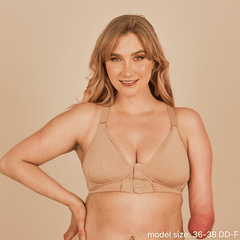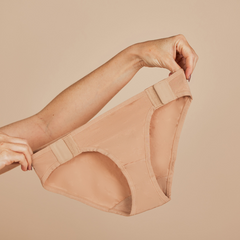
Osteoarthritis, a condition linked to joint “wear and tear”, is one of the most common forms of arthritis and joint discomfort.
Osteoarthritis is a chronic joint disorder that gradually wears down cartilage between joints, meaning it most commonly affects weight-bearing joints like the knees, hips, and spine, as well as the hands. Generally, symptoms include pain, stiffness and decreased joint flexibility.
While there's no cure for osteoarthritis, there are numerous strategies to help better manage its symptoms and maintain an active, comfortable life.
Osteoarthritis Tips For Managing Pain
Osteoarthritis Tip 1: Try To Maintain a Healthy Weight
One of the most effective ways to ease stress on weight-bearing joints is by maintaining a healthy weight. Not maintaining a healthy weight can exacerbate the symptoms of osteoarthritis, particularly in the knees and hips.
What is a healthy weight for someone depends on a large variety of factors and cannot be reduced to a single number as the BMI index does (the BMI index has been shown to be an inaccurate measure of health).
Of course, this isn’t always simple, particularly where pain and mobility problems already exist. Further, some medications may increase weight gain and this may be out of a person’s control.
In combination with mobility tools and adaptive clothing for osteoarthritis, you can collaborate with your healthcare provider to establish a weight management plan to try and reduce joint strain and improve general mobility.
Osteoarthritis Tip 2: Stay Physically Active

Physical activity again plays a crucial role in managing osteoarthritis. Where possible, low-impact exercises like swimming, stretching and walking are great for preserving joint flexibility and muscle strength without imposing excessive stress on your joints.
Trying to move impacted joints can help to relieve some stiffness and build up movement-specific muscles to help you to move around more easily. Aquatic exercise in particular has shown to moderately reduce pain and increase quality of life in initial studies published by the US National Institute of Health.
A pro tip is to try to get new shoes at a running store. They will often watch the way you walk, measure your arch, and determine the shoe that is the right fit for your needs. This can help relieve some common pain associated with exercise, such as knee or foot pain.
Osteoarthritis Tip 3: Adapt Your Home Environment
It’s possible to adapt your living space to become more osteoarthritis-friendly.
Install handrails, smart home features, and non-slip flooring to minimize the risk of a fall that might aggravate pain.
You should also consider incorporating adaptive tools and devices into your daily life, such as reachers, to reduce strain when performing regular tasks like reaching for objects or getting dressed.
Osteoarthritis Tip 4: Medication and Pain Management
Osteoarthritis can be uncomfortable and make day-to-day activity difficult. Consult with your healthcare provider to explore pain management strategies. In some cases, your doctor may recommend injections or topical treatments for localized pain relief.
This may require some trial and error as medications that work wonders for some, don’t show effectiveness for other people. It’s easy to get discouraged, but hopefully you’ll be able to fine tune what works for you.
Osteoarthritis Tip 5: Consider Assistive Devices

Adaptive tools, clothing and specialist devices are invaluable for those with osteoarthritis.
They can significantly enhance quality of life, making regular tasks easier to do whilst removing the likelihood of strains or added discomfort.
A great example is an adaptive bra with a front velcro closure. Not only is a good front fastening arthritis bra essential for independence, but it can help to alleviate pain by avoiding excessive strain to those problem areas. (They’re also really comfortable and look great.)
Osteoarthritis Tip 6: Physical Therapy
If you have diagnosed osteoarthritis, then it’s quite likely that a medical professional has already looked into physical therapy for managing discomfort. A physical therapist can help to develop a personalized exercise program tailored to your specific needs, focusing on strengthening the muscles around affected joints and improving mobility.
Read three tips for physical therapy.
Osteoarthritis Tip 7: Balancing Rest and Activity
As with any injury, it’s important to strike the right balance between rest and activity.
While staying active is crucial, it's equally important to allow your joints the time they need to rest and recover. Listen to your body and tailor your activities to match your comfort level.
Sometimes people get a burst of energy and go from a fully sedentary life to an active life. This is great, but it can lead to fatigue, giving up, and injury. If you are currently sedentary, set an achievable goal for yourself and work your way up.
Osteoarthritis Tip 8: Healthy Diet

Try to embrace a nutritious diet rich in fruits, vegetables, and anti-inflammatory foods wherever possible to support joint health. Omega-3 fatty acids, found in fish and flaxseed, can possess anti-inflammatory properties beneficial for individuals with osteoarthritis.
Individuals in blue zones (meaning people there disproportionately live into their 100s versus the general population) tend to consume a diet heavy in vegetables and they have lower rates of chronic illness than other populations. There are other factors at play, but a diet rich in plants, small amounts of red meat, and regular movement are certainly contributing factors.
Living with osteoarthritis doesn't mean resigning yourself to a sedentary or uncomfortable life.
With a combination of adaptive tools and purposeful activity, you can manage your pain and create an environment tailored to your needs without excessive pain and difficulty.



